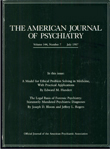Controlled study of psychiatric comorbidity in psychiatrically hospitalized young adults with substance use disorders
Abstract
OBJECTIVE: The purpose of this study was to examine DSM-III-R axis I and axis II comorbidity in psychiatrically hospitalized young adults with substance use disorders. METHOD: Structured diagnostic interviews were given to 117 consecutive inpatients. Seventy patients with substance use disorders and 47 patients without substance use disorders were compared. RESULTS: High rates of co-occurrence of axis I disorders were observed, but no disorder coexisted in the group with substance use disorders at a significantly higher rate than in the group without substance use disorders. Among axis II disorders, borderline personality disorder was diagnosed significantly more frequently in the group with substance use disorders. CONCLUSIONS: Significant additional diagnostic co-occurrence, defined as comorbidity, was observed only between borderline personality disorder and substance use disorders. The use of a relevant psychiatric comparison group allows for finer distinctions between covariation based on shared severity and comorbidity possibly based on shared pathophysiology.



